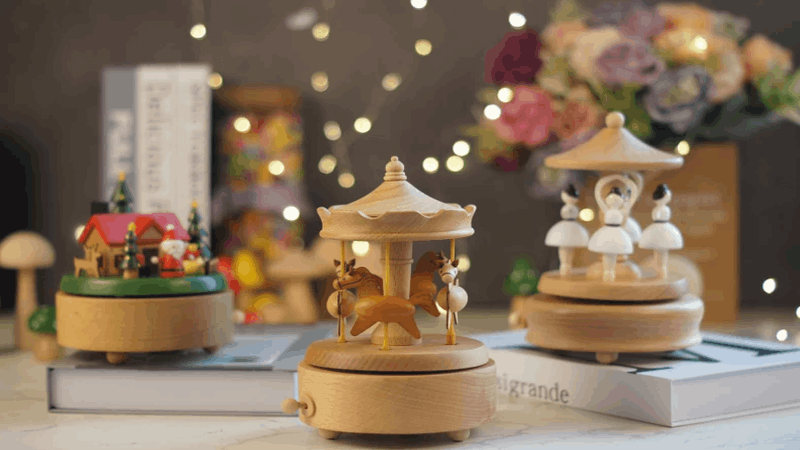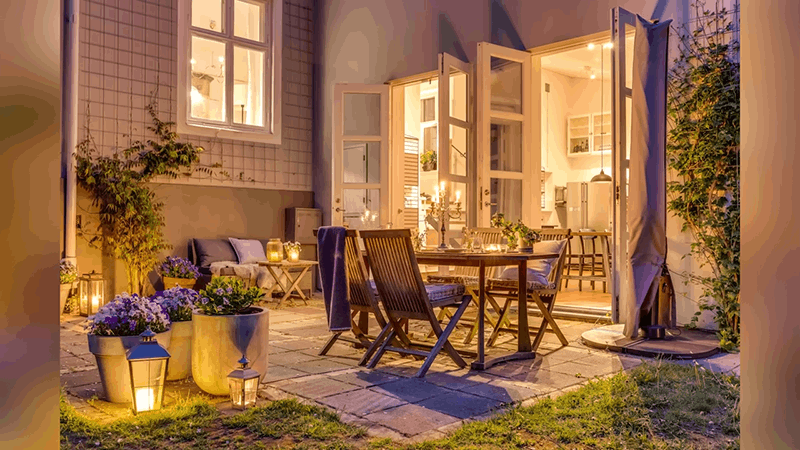No products in the cart.
Blog
Wooden Cutting Boards: The Ultimate Kitchen Essential
Wooden cutting boards have stood the test of time as a kitchen staple, offering unparalleled functionality and charm. From their gentle touch on your knives to their natural antibacterial properties, these handcrafted boards are more than just a pretty addition to your countertop.
This blog will examine the advantages of wooden cutting boards and their ongoing appeal to home cooks and professional chefs alike. Learn how to improve your cooking experience with these attractive and functional boards, which are frequently included in the larger category of handcrafted wooden objects.
Why Wood is Still the Best Cutting Board
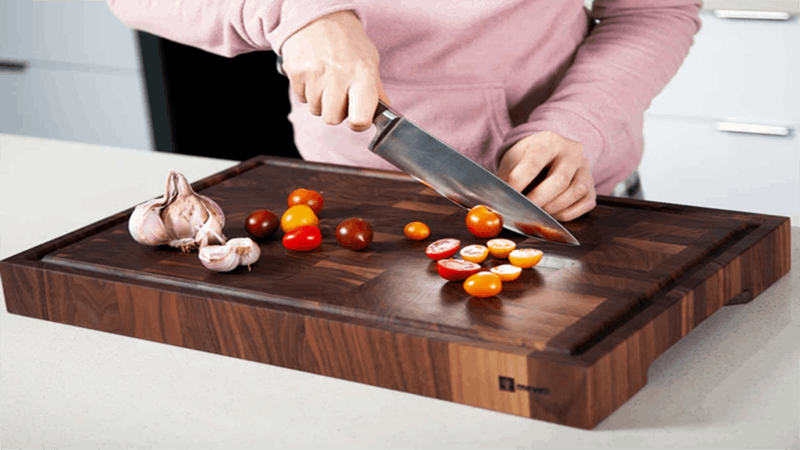
Wooden cutting boards remain the preferred choice for many chefs and home cooks due to their durability, aesthetic appeal, and knife-friendly surface. To remain a hygienic and long-lasting kitchen tool, wood’s natural antibacterial properties and ability to be resurfaced are the factors that we should consider.
Unlike materials such as plastic or glass, wood’s resilience and gentle nature on knives make it the best option for food preparation, particularly when it comes to handcrafted items.
What is a Wooden Cutting Board Used For?
A wooden cutting board is used for various food preparation tasks. The benefits include:
- Knife-friendly surface: Wooden boards are gentler on knives, maintaining their sharpness and reducing the need for frequent sharpening.
- Antibacterial properties: Certain woods contain natural antimicrobial compounds that inhibit bacterial growth so they are becoming a hygienic choice.
- Durability and longevity: High-quality wooden boards can last for years with proper care, and can be sanded and refinished to renew their surface.
- Aesthetic appeal: Wooden cutting boards, like many handcrafted wooden items, add rustic charm and beauty to the kitchen with their unique grain patterns and colors.
Wooden Cutting Boards and Other Materials: The Comparison
There are several materials to choose when thinking of cutting boards. Here’s how wooden cutting boards compare to other common materials.
- Plastic: Inexpensive and dishwasher-safe but prone to deep cuts that harbor bacteria and cannot be easily resurfaced.
- Glass: Easy to clean but harsh on knives and prone to shattering.
- Bamboo: Eco-friendly and hard but can be tough on knives and requires frequent maintenance.
- Wood: Durable, knife-friendly, and aesthetically pleasing with natural antibacterial properties, making it superior to plastic, glass, and bamboo cutting boards.
What is the Best Wood for a Cutting Board?
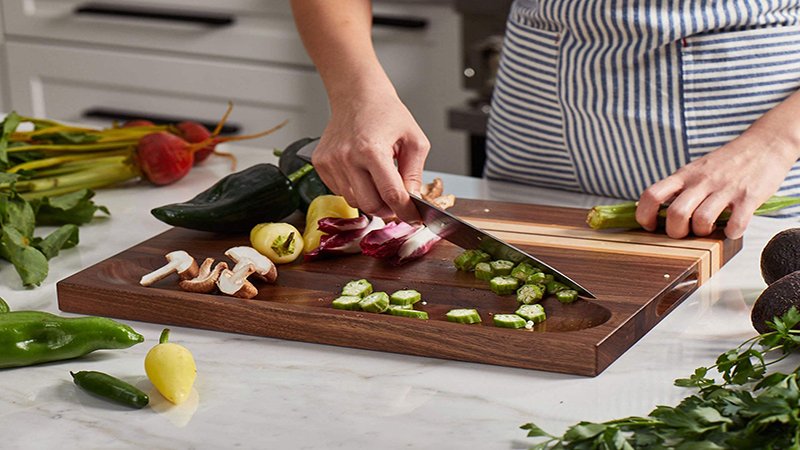
To make a high-quality cutting board, choosing the right wood is important. Some of the best woods for cutting boards include:
- Maple: Known for its durability and tight grain, maple is one of the most popular choices. It’s less likely to scar and offers excellent antibacterial properties.
- Walnut: Walnut boards are not only beautiful but also functional. They are gentle on knives and still durable because they are softer than maple.
- Cherry: Cherry wood offers a rich color and smooth texture. It might be more expensive than other options, however, it’s durable and provides a good cutting surface.
Is Acacia Wood Good for Cutting boards?
Acacia woods are durable, water-resistant, and have a beautiful grain pattern so they are an excellent choice for cutting boards. Acacia wood is renowned for being tough so it is hard for scratches and cuts to harm them. However, their hardness can be a bit tough on knives, so regular maintenance is key.
Wood not to Use for Cutting Boards
When selecting wood for cutting boards, avoid using softwoods such as pine, cedar, or fir. These woods are too soft, prone to developing deep cuts and grooves that can harbor bacteria, and may contain sap or resin that can affect the taste of your food. Additionally, avoid using toxic woods like oak or walnut that have open grains, which can trap food particles and bacteria.
How to Make Cutting Boards Wooden?
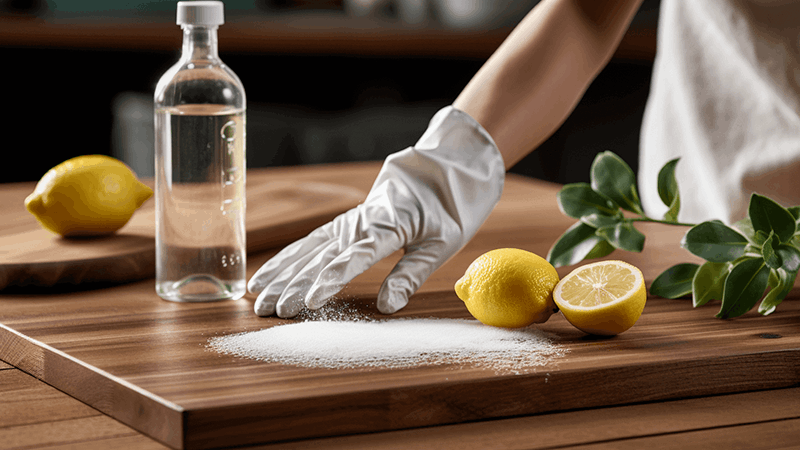
Making a handcrafted wooden cutting board can be a rewarding DIY project. Here’s a step-by-step guide:
- Select your wood: Choose hardwoods like maple, walnut, or cherry for their durability and aesthetic appeal.
- Cut the wood: To cut the wood into strips of equal width, using a table saw is recommended.
- Arrange and glue: Arrange the strips in a pattern and apply wood glue to the edges. You should wait at least 24 hours to clamp them tightly together and let them dry.
- Sand the board: To smooth the surface of the board, a sander should be used once the glue has dried. Start with coarse-grit sandpaper and progress to finer grits.
- Trim the edges: A saw should be used to trim the board’s edges for a smooth, even finish.
- Finish the board: To protect the wood and enhance its appearance, you should apply a food-safe finish like mineral oil or beeswax.
- Add handles (optional): For added functionality, you can cut handles into the sides of the board using a jigsaw.
A beautiful and functional wooden cutting board that can last for years will be created with these steps.
How to Oil Wood Cutting Board?
To maintain the quality and longevity, oiling your wooden cutting board is so essential. Following these steps to ensure your board remains in top condition:
- Clean the board: To remove any food particles or moisture, you should start by thoroughly washing and drying the cutting board.
- Apply oil: Use a clean cloth or paper towel to apply a generous amount of mineral oil or cutting board oil to the board’s surface.
- Let it absorb: Allow the oil to soak into the wood for at least 15-30 minutes to penetrate deeply and nourish the wood.
- Wipe excess: To avoid a sticky residue, use a clean cloth to wipe off any excess oil that remains after it has been absorbed.
- Repeat regularly: Reapply oil every few weeks or as needed to keep the board well-maintained and prevent drying out.
Regularly oiling your handcrafted cutting board not only keeps it looking good but also extends its lifespan.
Oils are Used on Wood Cutting Boards
Choosing the right oil for your wooden cutting board is crucial for maintaining its appearance and functionality. Here’s what you should use:
- Mineral oil: This is the most commonly recommended oil for wooden cutting boards. The wood can be protected from drying out and it will keep food safe.
- Cutting board oil: Specially formulated for use on cutting boards, this often contains mineral oil and other additives to enhance the wood’s durability.
- Beeswax: Often used in combination with mineral oil, beeswax helps to create a protective barrier and gives the board a smooth finish.
- Avoid vegetable oils: Oils like olive or canola can go rancid over time and are not recommended for cutting boards.
Your wooden cutting board will be a reliable kitchen tool and using the right oil will help maintain its integrity.
How to Clean a Wooden Cutting Board?
The hygiene and longevity of your wooden cutting board will be maintained by proper cleaning. Follow these steps:
- Wash with warm soapy water: After each use, scrub the board with warm water and mild dish soap. Avoid soaking the board to prevent warping and cracking.
- Disinfect with vinegar: Spray the board with white vinegar or wipe it with a vinegar-soaked cloth. Give it a few minutes to settle before washing.
- Remove stains with lemon and salt: Sprinkle coarse salt on the board and rub with a cut lemon. Rinse with water and dry thoroughly.
- Dry immediately: Dry the cutting board immediately with a clean towel. Stand it upright or on its side to ensure complete drying.
- Deep clean periodically: Occasionally sprinkle baking soda on the board and scrub with a damp sponge. Rinse thoroughly and dry.
By following these instructions, your wooden cutting board and other handcrafted wooden things will stay clean, hygienic, and in outstanding shape for many years to come.
Can You Put a Wooden Cutting Board in the Dishwasher?
It is not advised to run a wooden cutting board through the dishwasher. The wood may split, distort, and crack as a result of the heat and extended exposure to moisture, greatly shortening its lifespan. Instead, hand wash your wooden cutting board with warm, soapy water and dry it immediately to maintain its quality and longevity.
Conclusion
Knife-friendly surfaces, inherent antibacterial qualities, and unparalleled durability characterize wooden cutting boards, which belong to a larger group of handcrafted goods. By investing in one, you enhance your cooking experience with a practical and beautiful tool. Accept the ageless advantages of wooden chopping boards and improve the way you prepare food.
Hello, I am Althea Stone, a devoted enthusiast of handicrafts, finds solace and creativity in the intricate artistry of handmade goods. My passion for crafting extends beyond mere hobby, serving as a gateway to self-expression and a means to infuse everyday life with beauty and ingenuity.


